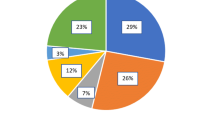Abstract
In this paper we analyze a continuous review, lost sales (S−1,S) inventory system with two demand classes—high priority and low priority. We compare two different policies—one where the two classes of customers are treated exactly alike and the other where a threshold rationing policy is used. We prove that under certain conditions there is a sub-optimal rationing policy which yields a lower cost for the supplier and higher service levels for both the high priority and low priority customers than the optimal policy where the two customers are treated alike.
Similar content being viewed by others
References
Arsalan, H., Graves, S. C., & Roemer, T. A. (2007). A single-product inventory model for multiple demand classes. Management Science, 53(9), 1486–1550.
Dekker, R., Hill, R. M., & Kleijn, M. J. (2002). On the (S−1,S) lost sales inventory model with priority demand classes. Naval Research Logistics, 49(6), 593–610.
Deshpande, V., Cohen, M. A., & Donohue, K. (2003). A threshold inventory rationing policy for service-differentiated demand classes. Management Science, 49(6), 683–703.
Ha, A. Y. (1997a). Stock rationing policy for a make-to-stock production system with two priority classes and backordering. Naval Research Logistics, 44(5), 457–472.
Ha, A. Y. (1997b). Inventory rationing in a make-to stock production system with two priority classes and backordering. Management Science, 43(8), 1093–1103.
Ha, A. Y. (2000). Stock rationing in an M/E k /1 make-to-stock queue. Management Science, 46(1), 77–87.
Isotupa, K. P. S. (2011). An (s,Q) inventory system with two classes of customers. International Journal of Operational Research, 12(1), 12–19.
Kimes, S. E. (1989). Yield management: a tool for capacity constrained service firms. Journal of Operations Management, 8, 348–363.
Kleijn, M. J., & Dekker, R. (1999). An overview of inventory systems with several demand classes. Lecture Notes in Economics and Mathematical Systems, 480, 253–265.
Kranenburg, A. A., & van Houtum, G. J. (2007). Cost optimization in the (S−1,S) lost sales inventory model with multiple demand classes. Operations Research Letters, 35(4), 493–502.
Moon, I., & Kang, S. (1998). Rationing policies for some inventory systems. Journal of the Operational Research Society, 49(5), 509–518.
Nahmias, S., & Demmy, S. (1981). Operating characteristics of an inventory system with rationing. Management Science, 27(11), 1236–1245.
Sapna Isotupa, K. P. (2006). Continuous review (s,Q) inventory system with two types of customers. International Journal of Agile Manufacturing, 9(1), 79–86.
Sivakumar, B., & Arivarignan, G. (2008). A modified lost sales inventory system with two types of customers. Quality Technology and Quantitative Management, 5(4), 339–349.
Vienott, A. F. Jr. (1965). Optimal policy in a dynamic, single product, non-stationary inventory model with several demand classes. Operations Research, 13(5), 761–778.
Author information
Authors and Affiliations
Corresponding author
Appendix: Inventory Level Distribution
Appendix: Inventory Level Distribution
We first determine the steady state distribution for Policy 1. Define
Since I(t) is a Markov chain, P 1(i,j,t) satisfies the following Chapman Kolmogorov forward equations.
where x j is the transition rate out of state j, y j+1 is the transition rate from state j+1 to state j and z j−1 is the transition rate from state j−1 to state j. Given that there can be only one unit of demand arriving at a time and that each replenishment is only of size one, the only way that state j can be reached is from state j+1 or state j−1. Since we are only interested in the long run expected cost rate, it is enough to determine the steady state probabilities. Since the Markov chain is aperiodic, irreducible and has a finite state space, a unique stationary distribution, P(j), which is the steady state probability that inventory level is j exists and is given by
Case 1: j=0
Exit from state 0 occurs when one of the S pending orders materializes, hence x 0=Sμ. The entry into state zero can occur from state 1 if a HP demand occurs, hence y 1=λ 1.
Case 2: 1≤j≤k−1
In this case the exit from state j can either be due to a demand from a high priority customer or due to one of the pending (S−j) orders materializing. Hence, x j =λ 1+(S−j)μ. The entry into state j can occur from state j+1 due to a demand from an HP customer and consequently y j+1=λ 1. The entry into state j can also occur from state j−1 if one of the S−j+1 pending orders arrives and hence z j−1=(S−j+1)μ
Case 3: j=k
The exit out of state k occurs in a similar fashion as in Case 2 and hence x k =λ 1+(S−k)μ. Entry into state k from state k+1 can occur due to a demand from either type of customer as inventory level is now greater than the threshold level. Hence y k+1=λ 1+λ 2. Entry into state k from state k−1 occurs in the same fashion as in Case 2 and hence z k−1=(S−k+1)μ
Case 4: k+1≤j≤S−1
Now the exit out of state j can occur due to a demand from either type of customer or by one of the S−j pending orders arriving. Hence x j =λ 1+λ 2+(S−j)μ. Transition into state j from state j+1 occurs if there is a demand from either type of customer and hence y j−1=λ 1+λ 2. Transition from state j−1 to state j occurs due to a replenishment of one of the S−j+1 pending orders and thus z j−1=(S−j+1)μ.
Case 5: j=S
From state S, the transition out can only occur due to a demand from either type of customer and hence x S =λ 1+λ 2. Transition into state S can only occur from state S−1 if the single pending order materializes and hence z S−1=μ.
Using the values of x j , y j and z j from Cases 1 to 5 in Eq. (11) and solving the system of equations in (11), we get after using the normalizing condition that sum of all the probabilities adds up to 1, we get


where
Note that the only difference between Policy 1 and Policy 2 is the method by which demand from an LP customer is dealt with. In Policy 1, when inventory level is less than or equal to the critical level, k (also called threshold level by some authors), and a demand from an LP customer arrives, it is lost. In Policy 2, demand from an LP customer is lost only if the demand occurs when inventory level is zero. Hence the steady state inventory level distribution for Policy 2 can be obtained from the steady state inventory level distribution of Policy 1 by taking the limit as k tends to zero. Taking the limit as k tends to zero in Eqs. (12), (13) and (14), we notice that Eq. (12) will not exist and that Eqs. (13) and (14) get transformed to the following two equations.


Proof of Theorem 1
Let \(C_{2} ^{*}(S)\) denote the optimal cost in the case where there is no differentiation between customers. If \(C_{2} ^{*}(S) - C_{1}(2,S+1) \geq0\), for the optimal value of S under Policy 2, then the threshold rationing policy will yield a lower total cost than the policy where the customers are treated alike because C 1(2,S+1) will always be greater than or equal to the optimal total cost in the threshold rationing policy. The numerator of \(C_{2} ^{*}(S) - C_{1}(2,S+1)\) after simplification is given by

The above term is non-negative if the following conditions hold.
-
(i)
(g 1−c)λ 1≥h
-
(ii)
(g 2−c)λ 2≥h
-
(iii)
\(\frac{(S + 2)\mu}{\lambda _{1}}\frac{(S + 1)\mu}{\lambda _{1} + \lambda _{2}} - 1\geq 1\)
The above expression hold true if \(\frac{(S + 2)\mu}{\lambda _{1}}\geq2\) and \(\frac{(S + 1)\mu}{\lambda _{1} + \lambda _{2}}\geq1\). Both these expressions hold if \(\frac{(S + 1)\mu}{\lambda _{1} + \lambda _{2}}\geq1\) and λ 1≤λ 2.
-
(iv)
\(\frac{(g_{1} - c)\lambda _{1}}{ \{ 1 + \sum_{j = 1}^{S} \frac{S!}{(S - j)!} ( \frac{\mu}{\lambda _{1} + \lambda _{2}} )^{j} \}}\geq h\)
-
(i)
But \(\frac{1}{ \{ 1 + \sum_{j = 1}^{S} \frac{S!}{(S - j)!} ( \frac{\mu}{\lambda _{1} + \lambda _{2}} )^{j} \}} = P_{2}(0)\). Hence the above expression is non-negative if (g 1−c)λ 1 P 2(0)≥h
-
(ii)
\(\frac{(S + 1)(S + 2)\mu ^{2}}{\lambda _{1}(\lambda _{1} + \lambda _{2})} - \frac{(S + 2)\mu}{\lambda _{1}} - 1\geq0\)
The above holds if \(\frac{(S + 1)\mu}{\lambda _{1} + \lambda _{2}}\geq2\) and λ 1≤λ 2.
Hence the theorem. □
Rights and permissions
About this article
Cite this article
Sapna Isotupa, K.P. Cost analysis of an (S−1,S) inventory system with two demand classes and rationing. Ann Oper Res 233, 411–421 (2015). https://doi.org/10.1007/s10479-013-1407-3
Published:
Issue Date:
DOI: https://doi.org/10.1007/s10479-013-1407-3




